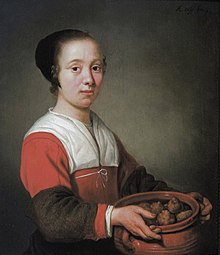
So far, dear readers, I have presented many savoury (and mostly fried!) variations of Dutch cuisine. Today we’re going to talk about the afternoon – and the nice habit of ordering a piece of cake with your coffee on the way.
My colleague BCO, who in February in his article “Too much bloody choice!” shared with us his traumatic experience of ice cream selection in the Ben & Jerry’s factory, should be delighted in Dutch cafes, because often the selection consists only of “appeltaart with cream” and “appeltaart without cream”. Life can be so simple!
The Dutch appeltaart – apart from apples, of course – usually contains quite a lot of cinnamon and raisins and I find it very tasty. My only complaint is that in many cafes it is kept very, very cold and therefore eaten very cold.
In some regions of the Netherlands the selection is usually supplemented by a regional speciality. If you travel to ‘s-Hertogenbosch in the province of Brabant, for example, you will find the “Bossche Bol” in every café and pub – it is a kind of profiterole dipped in dark chocolate and filled with cream. The choux pastry required for this is called “soezenbeslag” (pronounced: Susan!) in the Netherlands, which sounds attractive anyway!

If you are travelling in the province of Limburg, you will find “Limburgse vlaai” everywhere. This is a flat cake made of yeast or short pastry, usually topped with fruit and pastry lattice or crumble. Vlaai was already baked in the 12th century and over time became popular throughout the country. There are now also modern vlaai variations with cream or fresh fruit – but a real Limburg Vlaai must be baked with all its ingredients, without any ingredients being spread, sprayed or sprinkled on it after baking.
A nationwide speciality is “Poffertjes”, which are now also well known in Germany because there are also Poffertjes booths at the larger German Christmas markets. Poffertjes are a kind of mini pancake, whereby yeast is added to the pancake batter, which is why they are a bit thicker than a normal pancake. They are sprinkled with icing sugar and a pinch of butter – my personal favourite sweet temptation!
At the turn of the year we eat oliebollen – and now we get out the deep-fryer again! They are roughly comparable to traditional doughnuts but mostly with raisins instead of jam. They are sprinkled with icing sugar and eaten warm. Oliebollen have a long tradition in the Netherlands, which is also proven by the painting “Girl with a pot of oliebollen” by the Dutch painter Aelbert Cuyp. According to Wikipedia, this work was painted around 1652.

The first recipe appeared in a cookery book from 1667, and even then the oliebollen were a kind of winter snack, as the ingredients (flour, yeast, dried fruit) were also available in winter.
We can visit neighbouring countries again now. When the time comes, you will be ready for the sweet temptations – and prepared for another article about Dutch biscuits.
German text: BBR
English translation: BCO
Bildquellen
- appeltaart: Bildrechte beim Autor
- 20200502_152708: Bildrechte beim Autor
- Foto Meid met oliebollen: BBR - Fotografie einer Postkarte / Dordrechts Museum

